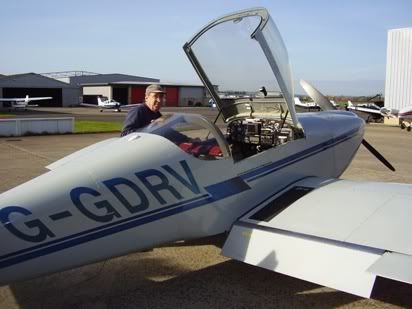Being without a share gives you the chance to assess where you are with your flying and what you might want to do. As a result, a few weeks ago, I started aerobatics training with a club aircraft.
As regards the share, well, I have done some touring and certainly done the ‘spamcan thing’. I think my flying and priorities now are:
• Try to reduce the cost (both monthlies and hourlies),
• Group of an absolute maximum of six (still not ready to go the whole hog and buy my own)
• I will still do touring mainly
• Ideally, the aircraft would also be aerobatic (e.g. Bulldog etc.)
• An ‘interesting’ aircraft or certainly something interesting about it (e.g. if it is a Cessna spamcan, maybe based at a farmstrip etc.)
• Ideally four seat, but wouldn’t rule out two seat.
• Would consider a PFA permit (should be cheaper to run) but would be sorry to lose use of IMC rating)
That’s a pretty long list, but really uppermost would be the need to reduce the cost and to fly something ‘interesting’.
Having had a look at a few locations, and options I kept coming back to Gloucester as being the ideal airfield. I did see a share in a very nice DR400 based at Bidford, but when I went to Bidford, there was no flying due to water-logging of the grass strip (kind of limiting) and they wanted a ‘mere’ £27,000 for the share – so a quick no on that!
I had heard that Manuel Quieroz was selling shares in his tidy RV6 based at Gloucester (he flew solo around the world in this plane in the ‘chasing the morning sun’ expedition). It is a group of six with five shares now sold. The monthlies and hourlies are reasonable and it certainly meets the ‘interesting aircraft’ requirement, although disappoints for aerobatics and IMC etc. (but I had long ago reconciled myself to not being able to have everything in one package unless I bought outright).
I have spoken to Manuel a few times and of course heard his talk on his epic flight at the Flyer Summer Bash this year. He is well known, well liked and respected and we seem to get on fine.
I talked to him about the share. The weight and balance is interesting, with a MAUW of 907kg for single occupancy (i.e. pilot only) but only 726kg for a pilot plus a passenger – apparently as legacy of his round the world trip, where he was surrounded by fuel tanks everywhere (and probably only had two pairs of underpants and a toothbrush for baggage!). The ‘dual occupancy’ MAUW was disappointing, but could be made to work for myself and the wife, or someone significantly lighter than my 210lbs MAUW!
An interesting aircraft in that it is very high performance (150kts) and a taildragger.

I have heard great things about RV’s and the near fanatical following and loyalty they engender. Claims of ‘fighter-like’ handling and ‘a joy to fly’ did more than pique my curiosity. Could these claims be true? If so, would that be enough to overcome the missing ticks in the requirements list?
The only thing for it was a trial flight. We tried for this last weekend but were defeated by a fog which never lifted around the airfield (although apparently it was glorious a mere five miles away). We were reduced to sitting in the aircraft in the hangar with the canopy down, making aircraft noises! The serious point was of course to see whether I ‘fitted’ with my 6’ 2” frame and headsets on. The answer was ‘probably, maybe, just’. The padded band on top of my DC13.4’s was touching the canopy if I moved my head too far towards the outside. But I was still concerned to see how it would feel in flight with maybe some buffet. So we agreed to call each other the next Saturday and take a call on the weather.
This we duly did and the weather seemed quite flyable, with a low overcast at 2000’ starting to break up nicely, but something of a wind, albeit straight down runway 27.
Manuel carefully went through the walk-round checklist (undoubtedly for my benefit as I am sure he can do it blindfolded by now). We pulled her out, climbed on board and started up. The view forward while taxying is very limited as you would expect in a taildragger, but actually not as bad as I had thought.
The digital engine monitoring system would take a bit of getting used to as we did the power checks.
Cleared for take off as Manuel applied full power. At about 45kts, he nudges forward on the stick to get the tail up, then holds her down until flying speed and eases her off. All of this happens very quickly and we are flying after very little runway (partly due to a light fuel load and partly a 15kt headwind). Nonetheless, we are definitely climbing at a sprightly 1000’ - 1300’ fpm.
We head out west and level off. The speed builds to 150 kts indicated as Manuel brings the power back to about 75% cruise. It is a bit bumpy up here, so it is a good test for headroom clearance. I can honestly say that at no time in the flight was I aware of the restricted headroom or of my headband touching the canopy.
Manuel demonstrates the sensitivity and feel of the controls by raking the RV over into a very steep turn either way. The roll rate is very brisk indeed – closer to the Extra 300 than the more sedate Robin! He demonstrates that it is very sensitive in pitch, with some positive G pull-ups and ‘bum off the seat’ push-over bunts.
He invites me to try the controls. He is right of course. The stick is best flown with thumb and forefinger and what I can best describe as ‘pressure’ in the direction you want to go. I needs little more than rudder pressure for a balanced turn and most passengers wouldn’t notice if you turned without rudder. I really do see what they mean by ‘fighter-like’ response and ‘a joy to fly’ – this is great fun.
However, for those long ‘touring legs’ he also has a ‘heading and height’ auto-pilot that can be slaved to the GPS.
Manuel takes over again as we near Bredon Hill. He spots an aircraft slightly below on an opposite heading and decides to turn around to catch him back up to demonstrate the turn of speed. We stay above and well to the right as we catch up to what turns out to be an RV8. A quick wing-rock in acknowledgement as we head away and back to Gloucester.
On the way back, Manuel shows me the slow flight and stall characteristics. It wouldn’t be easy to stall without realising it as we are virtually hanging from the prop before it stall with a very benign nose down and almost immediately she is flying again. There is a bit of wing-drop to the left with full flaps, but nothing scary. Flying at 100kts in slow flight feels like we are standing still.
Back to the airfield and we get a standard overhead join for 27. Back to 100 kts for the circuit. Conventional ‘three-point’ attitude for landing and control with the throttle. We touch and bounce, Manuel controls the bounce and we touch and hop again before finally settling. She really wanted to carry on flying.
Well what to do? It is a really interesting aircraft and will need me to get my taildragger rating (I already have 7 hours taildragging on the Cub and was close to sign-off before the clock change put paid to evening lessons after work). Manuel is happy for me to train in the RV6 – in fact it is so massively different from the cub, I would need difference training anyway! It is fast and would be a fine tourer for two people with careful luggage management.
I left it with Manuel that I would check with the wife, as the £10,000 share is significant ask on the finances. I am sure she will be OK about it. I have to say, I think I will do it – for aerobatics I can always rent to Robin and for the odd touring with two really heavy guys in the seats, I can always do a full rental of the Arrow or similar.
I think I’ll probably do this. The guys in the tower at Gloucester may be in for some serious entertainment as regards landings shortly!
